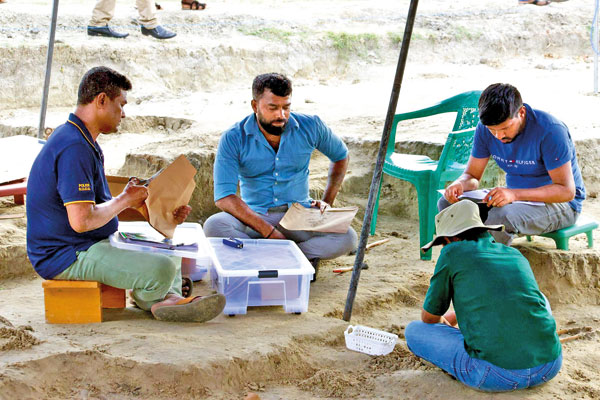News
Chemmani mass graves: Childrens’ skeletons suspected among them
View(s):By S. Rubethesan
Among the 42 human skeletons that have been recovered from the Chemmani Siththupaththi Hindu Cemetery so far, at least three of them are suspected to be those of children.
When the excavation team was clearing the 11-foot-long rectangular-shaped site this week, a dress, a bag, slippers, and a toy were also recovered.

Ongoing excavation of the Chemmani mass graves. Pic by N. Lohathayalan
V. S. Niranjan, Attorney at Law, who was present at the site representing the northern chapter of the Bar Association of Sri Lanka told reporters that the excavation process is being carried out in two places where it is suspected that more human remains are buried.
The second phase of the excavation has been ongoing for the past ten days following the directive issued by the Jaffna Magistrate Court. The first phase was in 1996.
During the excavation, 37 full human skeletons that were recovered were under judicial custody.
V. Manivannan, Attorney at Law, representing Nallur Pradeshiya Sabha, under whose purview the cemetery comes, also observed the ongoing excavation process on Friday.
“In one site, it was marked that there were five skulls and partial human remains buried together, and we hope that the excavation will continue further on the adjacent area—close to A9 road—since it is suspected that there could be more bodies buried in the nearby area,” he said.
“We noticed that the bodies were buried on an irregular basis and the absence of any dress or objects on those bodies. Among them, three remains are suspected to be those of children,” Mr. Manivannan said.
Meanwhile, a Writ of Mandamus filed on behalf of three persons who went missing in the Navatkuli area is scheduled to be taken up on July 11 at the Chavakachcheri Magistrate Courts.
| AI-generated images counterproductive and insensitive warn lawyers The AI-generated images of pictures taken at the site, which are going viral on social media, are counterproductive, lawyers have warned. Ranitha Gnanarajah, who is among the lawyers at the excavation site representing the affected community, said that that mass grave excavation is a sensitive issue that directly relates to the criminal justice process and is closely linked with the emotions of the relatives of the enforced missing persons. “When you create images with the support of AI, it directly affects the investigation that involves several teams of archaeologists, anthropologists, and other experts. These AI-created content and information disrupt the ongoing investigations,” the lawyer explained. “There would be contradictions between actual investigation and people’s understanding through AI images, leading to issues among the affected community,” she said. “Currently, the intervention of the criminal justice process is guided by the Jaffna Magistrate Court in order to establish the truth and justice for those who were made to disappear. That’s why AI-generated images pose a challenge to this process,” she warned.
| |
| Relatives of missing persons reopen dismissed cases In the wake of the new mass grave found in Chemmani, relatives of missing people whose loved ones disappeared in 1996-1997 are seeking to reopen the cases, which were dismissed over a decade ago. The Centre for Human Rights and Development (CHRD), a non-government organisation that closely worked on enforced disappearance cases, filed 45 habeas corpus petitions in the Jaffna High Court on behalf of the disappeared in the Navatkuli, Kaithady, Ariyalai, Pasaiyoor, and Gurunagar areas of the Jaffna peninsula in 2004. These cases followed a 2003 fact-finding mission in which CHRD lawyers documented 160 complaints of disappearances from 1996-1997. Of the 45 cases, 24 persons disappeared on July 19, 1996, during a cordon and search operation conducted by Lt. Col. Duminda Kepetiwalane, the commanding officer of the Navatkuli Army Camp, according to a brief note titled ‘Enforced Disappearances in Sri Lanka—Lessons from CHRD’s Advocacy” issued by the organisation in 2015. The cases were granted leave to proceed before the Chavakachcheri Magistrate Court for non-summary enquiries. In 2007, the Chavakachcheri Magistrate Court determined that there was substantial evidence to prove that security forces were behind many of the enforced disappearances that took place in 1996 in the Jaffna peninsula. Thereafter, the cases were transferred to the Anuradhapura High Court after the army respondents alleged that they could not get a fair trial in Jaffna. Families of the disappeared initially showed great interest and travelled to Anuradhapura for proceedings. “However, they faced harassment by unknown persons, and as the fighting in the Vanni increased, they could not travel to Anuradhapura. In late 2010, the families and their attorneys did not turn up in court for a hearing, and the Anuradhapura High Court dismissed all 45 cases on procedural grounds,” the brief note stressed. |
The best way to say that you found the home of your dreams is by finding it on Hitad.lk. We have listings for apartments for sale or rent in Sri Lanka, no matter what locale you're looking for! Whether you live in Colombo, Galle, Kandy, Matara, Jaffna and more - we've got them all!

